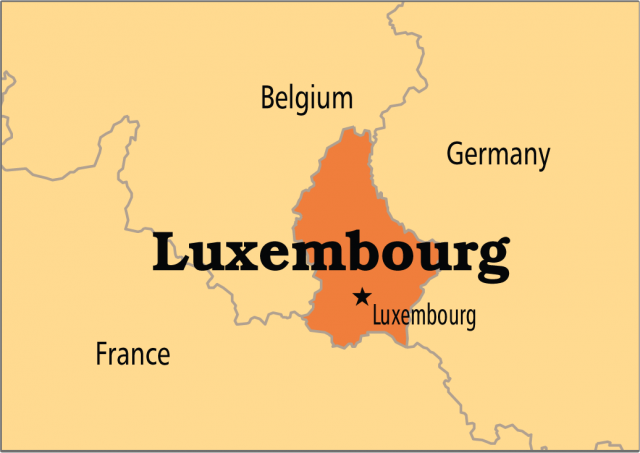Luxembourg
Area 998 square mi (2,586 square km)
Population 556,100 2014
Capital Luxembourg
Highest Point 1,834 ft (559 m)
Lowest Point 436 ft (133 m)
GDP $60.13 billion 2013
Primary Natural Resources arable land.
LUXEMBOURG IS a small LANDLOCKED western European country, within the EUROPEAN UNION (EU), and given its small population size, the country does not contain any large urban centers. After Luxembourg City, about 75,000 persons, the next largest settlements are Esch-sur-Alzette (27,000), Differdange (18,000), and Dudelange (17,000). Split into three administrative regions (Diekirch, Grevenmacher, and Luxembourg), Luxembourg is governed by a constitutional monarchy. Bordered by GERMANY to the east (the border being formed by the Our, Sure and Moselle rivers), FRANCE to the south, and BELGIUM to the west and north, the country has been historically and culturally influenced by countries neighboring it. Linguistically at least, the neighboring influence persists. Legal and political matters, for instance, are still written in French, while police records are noted in German. Officially, three languages (Luxembourgish—a mix of Frankish and old German—French, and German) are spoken in Luxembourg.

In terms of physical geography, Luxembourg has a temperate climate that can be characterized by cool, sometimes cold winters and warm summers. The northern part of the country forms part of the Ardennes hill range and has an undulating topography. The highest point is some 1,834 ft (559 m) above sea level, although the other regions of the country may be described as being somewhat hilly as well. In terms of land use, about 25 percent of land is cultivated, a further 20 percent is used for pasture, and 20 percent is wooded. Given its small spatial extent, Luxembourg has a relatively high population density, even though its urban places are not large demographically.
MODERN ECONOMICS
In economic terms, Luxembourg may be characterized as a low-unemployment, low-inflation, and high-income society. Industry, particularly steel, has historically been significant in Luxembourg but has in recent times been surpassed by the growth of other industries, such as rubber and chemicals, as well as the rise of the tertiary economic sector, especially the banking sector which is largely based in Luxembourg City.
Located at the junction of the Alzette and Petrusse rivers, Luxembourg City, the capital, is today a settlement of modern international banking repute and also the location of several European Union institutions. These include the European Court of Justice, the European Investment Bank, and the Secretariat of the European Parliament. Because of its exceptional location and the surrounding natural environment, Luxembourg City has historically been a place of military significance.
As an area noted in written history, Luxembourg dates from the 10th century when it was known as Lucilinburhuc (“little fortress”). At this time Siegfried, Count of Ardennes, erected a castle (now in Luxembourg City). From 1506 to 1890, Luxembourg formed part of the territories of numerous European countries, including SPAIN, France, AUSTRIA, and the NETHERLANDS, and it was not until 1815 that the process of independence in Luxembourg began, a consequence of the forming of a Grand Duchy by the Congress of Vienna. The Congress, held in 1814 and 1815, redrew the continent's political map following the defeat of Napoleonic France, and one of the principle results of the event, aside from the confirmation of France's loss of territories it had annexed between 1795 and 1810, was that the Luxembourg Grand Duchy was formed and the Netherlands became an independent kingdom.
As part of this Europe-wide development, the Luxembourg Duchy was handed to the Dutch monarch, William I. In 1838, political autonomy was granted to by the Netherlands, yet it was not until 1890 that Luxembourg became independent as such from the Dutch, a result of the death of William III. Upon his death William was succeeded by his daughter, but as only men could inherit the title of Grand Duke, it passed to another blood line of the Dutch royal house. The throne thus was offered to William's cousin, Duke Adolf of Nassau, who subsequently became Grand Duke Adolf I of Luxembourg. Today Luxembourg remains the world's only grand duchy.